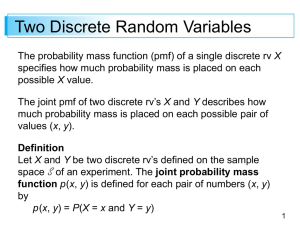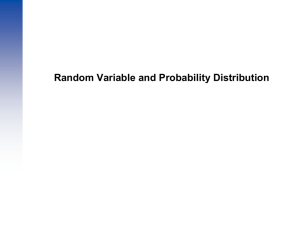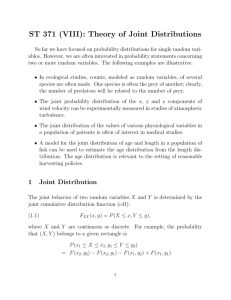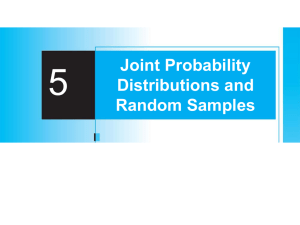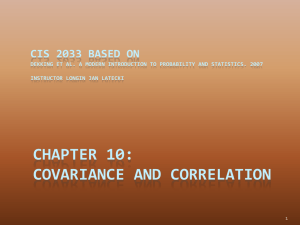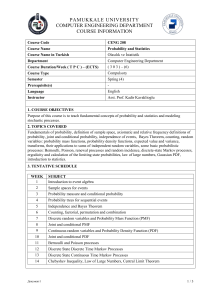Joint Probability Distributions and Random Samples
advertisement
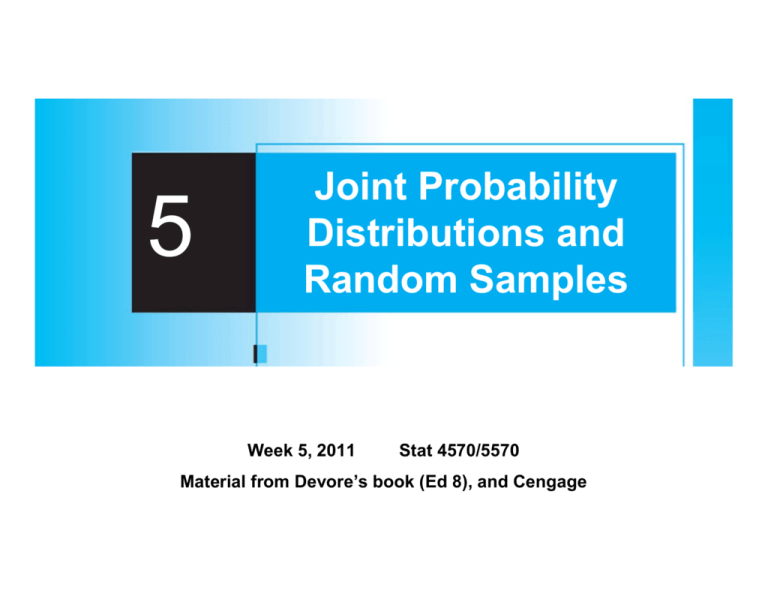
5
Joint Probability
Distributions and
Random Samples
Week 5, 2011
Stat 4570/5570
Material from Devore’s book (Ed 8), and Cengage
Two Discrete Random Variables
The probability mass function (pmf) of a single discrete rv X
specifies how much probability mass is placed on each
possible X value.
The joint pmf of two discrete rv’s X and Y describes how
much probability mass is placed on each possible pair of
values (x, y):
p (x, y) = P(X = x and Y = y)
2
Two Discrete Random Variables
Always:
p (x, y) ≥ 0
and
p (x, y) = 1
So what are events now?
A can be any set consisting of pairs of (x, y) values
(e.g., A = {(x, y): x + y = 5} or {(x, y): max (x, y) ≤ 3}).
Then the probability P[(X, Y) ∈ A] is obtained by summing
the joint pmf over pairs in A:
P[(X, Y) ∈ A] =
p (x, y)
3
Example 1
An insurance agency services customers who have both a
homeowner’s policy and an automobile policy. For each
type of policy, a deductible amount must be specified.
For an automobile policy, the choices are $100 and $250,
whereas for a homeowner’s policy, the choices are 0, $100,
and $200.
Suppose an individual – Bob -- is selected at random from
the agency’s files. Let X = his deductible amount on the
auto policy and Y = his deductible amount on the
homeowner’s policy.
4
Example 1
cont’d
What are the possible (X, Y) pairs?
Suppose the joint pmf is given by the insurance company in
the accompanying joint probability table:
What is p(100, 100)? What is P(Y ≥ 100)?
5
Example 1
What is the probability that X = 100? What is the probability
that X = 250?
The “marginal” pmf of X is (focuses only on X, and doesn’t
care what Y is):
What is the marginal distribution of Y?
6
Two Continuous Random
Variables
7
Two Continuous Random Variables
Let X and Y be continuous rv’s. A joint probability density
function f (x, y) for these two variables is a function
satisfying f (x, y) ≥ 0 and
Then for any set A
8
Two Continuous Random Variables
In particular, if A is the two-dimensional rectangle
{(x, y): a ≤ x ≤ b, c ≤ y ≤ d}, then
We can think of A as specifying a surface with height
f(x, y) above each point (x, y).
9
Two Continuous Random Variables
Then P[(X, Y) ∈ A] is the volume underneath the joint pdf
and above the region A, analogous to the area under a
curve in the case of a single rv.
P[(X, Y ) ∈ A] = volume under density surface above A
10
Example 3
A bank operates both a drive-up facility and a walk-up
window. Let
X = the proportion of time the drive-up facility is in use (at
least one customer served or waiting to be served) &
Y = the proportion of time the walk-up window in use
Say the manager has given us the joint pdf based on his
experience:
11
Example 3
cont’d
As a good probabilist, you first verify that this is a pdf.
1) f (x, y) ≥ 0 (check)
2) Does it integrate to 1?
What is the probability that neither facility is busy more than
one-quarter of the time?
12
Marginal Random Variables
The marginal probability density functions of X and Y,
denoted by fX(x) and fY (y), respectively, are given by
13
Independent Random Variables
14
Independent Random Variables
In many situations, information about the observed value of
one of the two variables X and Y gives information about
the value of the other variable.
Here, P(X = 250) = 0.5 and
P(X = 100) = 0.5
15
Independent Random Variables
Two random variables X and Y are said to be independent
if for every pair (x,y):
p (x, y) = pX (x) pY (y)
when X and Y are discrete
f (x, y) = fX (x) fY (y)
when X and Y are continuous
Or
If this is not satisfied for all (x, y), then X and Y are said to
be dependent.
16
Example 6
What about in the insurance example?
Independence of X and Y requires that every entry in the
joint probability table be the product of the corresponding
row and column marginal probabilities.
17
Conditional Distributions
18
Conditional Distributions
Suppose X = the number of major defects in a randomly
selected new automobile and Y = the number of minor
defects in that same auto.
If we learn that the selected car has one major defect, what
now is the probability that the car will have at least one
minor defect? That is, what is P(Y >= 1 | X = 1)?
19
Conditional Distributions
Let X and Y be two continuous rv’s with joint pdf f (x, y) and
marginal X pdf fX (x). Then for any X value x for which
fX (x) > 0, the conditional probability density function of Y
given that X = x is
If X and Y are discrete, replacing pdf’s by pmf’s in this
definition gives the conditional probability mass function of
Y when X = x.
Notice that the definition of fY | X(y | x) parallels that of
P(B | A), the conditional probability that B will occur, given
that A has occurred.
20
Example 1, cont
Reconsider the insurance example:
What is the conditional pmf of Y given that X = 10?
What is the expected value of Y given that X=100?
This is called the conditional expectation.
21
More Than Two Random Variables
If X1, X2, . . ., Xn are all discrete random variables, the joint
pmf of the variables is the function
p(x1, x2, . . . , xn) = P(X1 = x1, X2 = x2, . . . , Xn = xn)
If the variables are continuous, the joint pdf of X1, . . ., Xn is
the function f (x1, x2, . . ., xn) such that for any n intervals
[a1, b1], . . . , [an, bn], we have:
22
How to find an expected value of a function of two variables
If X and Y are jointly distributed rv’s with pmf p(x, y) or
pdf f (x, y), according to whether the variables are discrete
or continuous, then
Then the expected value of a function h(X, Y), denoted by
E[h(X, Y)] is given by
if X and Y are discrete
if X and Y are continuous
23
Example
You have purchased 5 tickets to a concert for you and 4
friends (one is Bob). Tickets are for seats 1–5 in one row. If
the tickets are randomly distributed among you, what is the
expected number of seats separating you from Bob?
24
Covariance
25
Covariance
When two random variables X and Y are not independent,
it is frequently of interest to assess how strongly they are
related to one another.
The covariance between two rv’s X and Y is
Cov(X, Y) = E[(X – µX)(Y – µY)]
X, Y discrete
X, Y continuous
26
Covariance
Since X – µX and Y – µY are the deviations of the two
variables from their respective mean values, the covariance
is the expected product of deviations.
Note that Cov(X, X) = E[(X – µX)2] = V(X).
If both variables tend to deviate in the same direction (both
go above their means or below their means at the same
time), then the covariance will be positive. If the opposite is
true, the covariance will be negative.
If X and Y are not strongly related, the covariance will be
near 0.
27
Covariance
The covariance depends on both the set of possible pairs
and the probabilities of those pairs.
Below are examples of 3 types of “co-varying”:
(a) positive covariance;
(b) negative covariance;
Figure 5.4
(c) covariance near zero
28
Example
Back to the insurance example:
are:
from which µX = ΣxpX(x) = 175 and µY = 125.
What is the covariance between X and Y?
Why might the covariance not be a useful measure?
29
Covariance shortcut
The following shortcut formula for Cov(X, Y) simplifies the
computations.
Proposition
Cov(X, Y) = E(XY) – µX µY
According to this formula, no intermediate subtractions are
necessary; only at the end of the computation is µX µY
subtracted from E(XY).
This is analogous to the “shortcut” for the variance
computation we saw earlier.
30
Correlation
31
Correlation
Definition
The correlation coefficient of X and Y, denoted by
Corr(X, Y), ρX,Y, or just ρ, is defined by
It represents a “scaled” covariance – correlation ranges
between -1 and 1.
32
Example
In the insurance example,
E(X2) = 36,250, so
= 36,250 – (175)2 = 5625, so σX = 75
E(Y2) = 22,500, so
σY 2 = 6875, and σY = 82.92.
This gives
33
Correlation
Propositions
1. Cov(aX + b, cY + d) = a c Cov (X, Y)
2. Corr(aX + b, cY + d) = sgn(ac) Corr(X, Y)
3. For any two rv’s X and Y,
–1 ≤ Corr(X, Y) ≤ 1
4. ρ = 1 or –1 iff Y = aX + b for some numbers a and b with
a ≠ 0.
34
Correlation
If X and Y are independent, then ρ = 0, but ρ = 0 does
not imply independence.
The correlation coefficient ρ is a measure of the linear
relationship between X and Y, and only when the two
variables are perfectly related in a linear manner will ρ be
as positive or negative as it can be.
A ρ less than 1 in absolute value indicates only that the
relationship is not completely linear, but there may still be a
very strong nonlinear relation.
35
Correlation
Also, ρ = 0 does not imply that X and Y are independent,
but only that there is a complete absence of a linear
relationship.
When ρ = 0, X and Y are said to be uncorrelated.
Two variables could be uncorrelated yet highly dependent
because there is a strong nonlinear relationship, so be
careful not to conclude too much from knowing that ρ = 0.
36
Example
Let X and Y be discrete rv’s with joint pmf
The points that receive positive
probability mass are identified
on the (x, y) coordinate system
What is the correlation of X and Y? Are X and Y independent?
37
Interpreting Correlation
A value of ρ near 1 does not necessarily imply that
increasing the value of X causes Y to increase. It implies
only that large X values are associated with large Y values.
For example, in the population of children, vocabulary size
and number of cavities are quite positively correlated, but it
is certainly not true that cavities cause vocabulary
to grow.
Association (a high correlation) is not the same as
causation.
38
Interpreting Correlation
xkcd.com/552/
39


